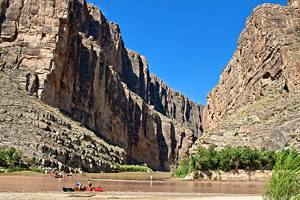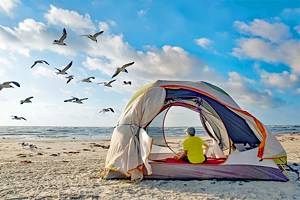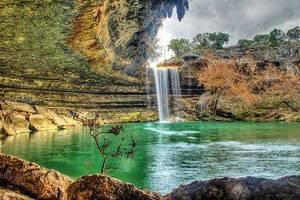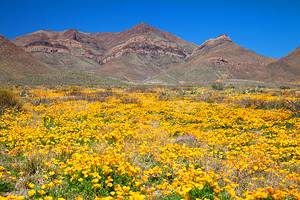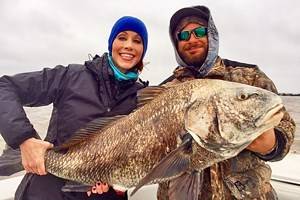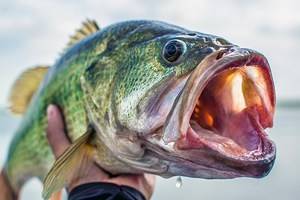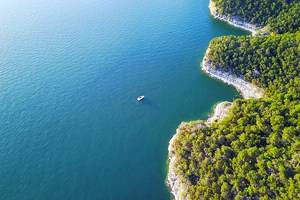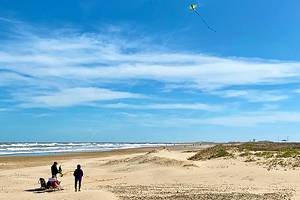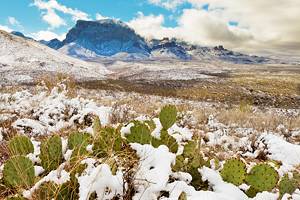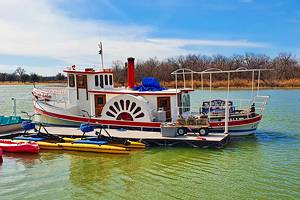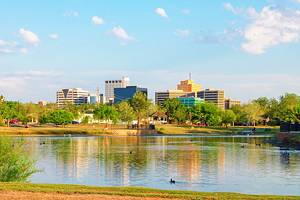Saltwater vs. Freshwater Trout Fishing in Texas & 9 Hot Spots
When you talk to Texans about trout fishing there's only one kind that comes to mind: spotted seatrout, a saltwater species. It's one of the top three saltwater species that anglers target in the state, along with red drum and flounder.
Trout anglers outside of the Lone Star State might find this a bit surprising if they plan to fish for trout the more traditional way, with waders in cold freshwater streams and a fly rod. While there is a small window of opportunity for freshwater rainbow trout in some parts of Texas during the colder months, it is not the primary trout for anglers in the state.
Nonetheless, both seabound and freshwater-bound anglers have plenty of trout opportunities. Be sure to get a proper fishing license from the Texas Parks and Wildlife Department before you head out on the water. Here are the best locations and top ways to target both saltwater and freshwater trout.
Saltwater Trout
The spotted seatrout is a saltwater species caught along the Texas coast and in the bay systems that stretch from Florida into Mexico. The popular trout live in shallow, brackish water.
Hardcore seatrout anglers can actually "sniff out" the trout. It's true. The oils produced when the trout regurgitate during excited feeding create a slick of undigested food that omits an odor described as watermelon or mowed grass. When sniffing out the seatrout is too much effort, you can attract them with live bait like shrimp, shad, and mullet, or artificial bait.
Spotted seatrout prefer shallow bays and estuaries, especially in the spring and summer. When water temperatures drop in the fall, the fish move into deeper bay waters and the Gulf of Mexico. If you are unfamiliar with a waterway along the coast, it is best to get local information from a nearby tackle shop about what tackle to use and the best times to fish.
Sabine Lake

Sabine Lake is one of the best spots in southern Texas to target spotted seatrout. I teamed up with expert guide Jerry Norris of Sabine Lake Guide Service to uncover what makes Texans so passionate about this kind of trout.
"They're great to eat, fun to catch, and available year-round," said Norris.
With our rods strapped down to the boat, Norris heads across Sabine Lake in Port Arthur, which is a half hour outside of Beaumont, to show me the techniques that work for spotted seatrout on most coastal waterways.
To my right is Louisiana and on my left is Texas with the state line running right down the middle of the five-mile-wide lake for 14 miles. With 90,000 acres of water branching off into smaller channels, there is plenty of territory to cover.
Norris decides to use artificial bait since the weather of the day will serve up changing conditions. We are using Bass Assassin artificial bait and a MirrOlure topwater She Dog with a rattle on our casting rods to attract the fish in the murky water.
The water is only four to five feet deep, which is ideal for seatrout. Norris has guided for trout on Sabine Lake since 1986, so he knows that this time of year the trout hover near the bank. The trout are feeding on mullet that are often seen jumping out of the water, so we know exactly where to cast our lines.
"The trout stay along the shoreline in the winter. The mullet come in to feed on the algae, and the trout feed on them," said Norris.
The water is calm for now, but the approaching front will change that in a few hours. Norris says ideal conditions are somewhere in between, when there is a slight current. While weather conditions are more unpredictable in the fall and winter, those are the best times to target seatrout in Sabine Lake.
The only downside of targeting seatrout is that they aren't the only species that feed on mullet. Redfish, which often run in schools, are also competing for the bait. We caught several of them.
Redfish are exciting to reel in as their aggressive dives in the water cause a lot of commotion. Then, there's the biggest food competitor, the bull sharks that frequent the lake. They have been known to eat fish right off anglers' lines while reeling in a catch.
While we had a number of great catches during the day, the seatrout that we came for were not in the cards on this trip. As most fishing trips go, sometimes you win and sometimes you lose, but you always get the gift of the outdoors and fishing someplace new.
Galveston Bay

While you can fish for seatrout on nearly any coastal waterway, Galveston Bay is known as one of the best locations in the United States for catching them, both in numbers and size. Trophy size speckled seatrout are common in the bay.
Some of the best areas are in the coves on the West Bay located along the south shoreline and Rollover Pass. Fat Rat Pass is another prime location. During warmer weather, the fish are in the shallow areas in the early morning and late evening.
During the heat of the day, you will want to move to deeper spots that have drop-offs around grass flats, channels, or oyster reefs. Surface baits, like the Floating Corky by BNL, are great attractors.
The bonus to catching a trophy size speckled trout in Galveston Bay is watching it aggressively leap out of the water to attack your bait.
East/West Matagorda Bays

Though the East and West Matagorda Bays are tough areas to get to, they are worth the effort for great seatrout fishing. You will have to access the prime areas either by boat or with a four-wheeler.
The Texas Parks and Wildlife Department has recorded seatrout as big as 36 inches in these waters. If accessing the areas by boat, you can reach the cove shorelines in the bays where the seatrout like to feed.
If accessing by a four-wheeler or a 4WD vehicle, you will want to go to the Matagorda East Jetty and work the beachfront sections. You won't run out of areas to target because the shoreline stretches for 24 miles.
Topwater bait is recommended, like the Rebel Jumpin' Minnow in green and bone color that you can twitch on the retrieve to excite the fish.
Mesquite Bay/Aransas Bay

Mesquite Bay and Aransas Bay are locations in central Texas with superb seatrout fishing opportunities. These bays are popular for wading where you can reach the grassy areas on the shorelines and focus on the oyster shell reefs, where the fish like to congregate.
Schools of seatrout will chase shrimp or small fish to the surface. You can try using live shrimp for bait or an artificial dark colored shrimp tail on a lead head jig. If you use artificial bait, try bouncing the shrimp tail along the bottom to simulate the action of the live shrimp.
Freshwater Trout
While most of the trout fishing in Texas is for spotted seatrout, there is a short season of freshwater trout fishing. Since freshwater trout need cool water to survive, the warm Texas temperatures do not provide a year-round opportunity for them.
The window for targeting rainbow trout is in late fall, winter, and early spring when the weather is cooler. From November through early March, the Texas Parks and Wildlife Department stocks more than 100 locations with rainbow trout.
Many of the state parks have fishing tackle available to borrow if you need it, but it is wise to check first with the location you plan to visit. The list of stocking locations changes each year, so you can reference the TPWD website before you plan your trip.
Canyon Tailrace

There is only one year-round freshwater trout fishery in Texas. It is the Canyon Tailrace on the Guadalupe River. This is the only stream with water conditions that are cool enough to support trout year-round.
The Canyon Tailrace fishery is located below Canyon Lake and is stocked by the Texas Parks and Wildlife Department and the Guadalupe River Chapter of Trout Unlimited (GRTU) each year.
The reason it can sustain freshwater trout through most of the year is because regular dam releases keep the water at a consistently cool temperature. You can find river access points at the Guadalupe Park near the dam. Some sections of the river have harvest regulations.
Garner State Park

Garner State Park is one of the top state parks to fly fish for freshwater trout in the state. The Frio River flows through the park, and it is stocked annually by the Texas Parks and Wildlife Department.
Garner State Park is located about eight miles north of the city of Concan. The rainbow trout fishing in the park is ideal for both novice and expert anglers.
There are many public access points, so even kids can enjoy a day of fishing on the water. Garner is one of the many state parks that has a tackle loaner site, where you can borrow fishing gear for the day. You can fish for free in all of the Texas State Parks.
Neighborhood Fishing Lakes

If you want to target rainbow trout in the cooler months in Texas, a great way to do that is at one of the 18 Neighborhood Fishin' lakes. They are located throughout the state and stocked with rainbow trout every two weeks from November to March.
This is a nice option for kids learning how to fish, and children under 16 can fish for free. For a full list of the lakes and the stocking schedules visit the TPWD website.
Blanco State Park

Blanco State Park is only about an hour from San Antonio and Austin, so it is a nice side trip for anglers who are visiting central Texas and looking for a close and quality trout fishery. The Blanco River is a popular trout fishery because of regular stocking and easy water access.
The river is stocked with rainbow trout several times during the winter months by the Texas Parks and Wildlife Department. The Blanco River is in Texas hill country, so the landscape is marked with scenic views accented by the limestone edges in the water and bald cypress.
Anglers have shoreline access to the Blanco River from the park. You can borrow fishing equipment from the park office if you forget something in your tackle.
Possum Kingdom Lake

The trout fishing at Possum Kingdom Lake is almost secondary to the views that anglers have on this waterway in north-central Texas. It does have a popular winter trout fishery with the most productive areas being the Possum Kingdom Lake tailrace and the Brazos River just below the reservoir.
The Texas Parks and Wildlife Department stocks the tailrace with about 9000 rainbow trout each year. You can access trout fishing areas from Possom Kingdom Lake State Park. There are over 300 miles of shoreline and plenty of access points.
One of the best trout pools to access is upstream from the Highway 16 bridge that crosses the Brazos River downstream from the dam. There is parking in the area and a number of access trails that parallel the river.
Map of Saltwater vs. Freshwater Trout Fishing in Texas & Hot Spots
More Related Articles on PlanetWare.com

More on Fishing in Texas: If you are interested in other types of fishing around the state, see our articles on the Fishing Lakes in Texas and the Places for Deep Sea Fishing in Texas. Since many of the locations are centered along the coast, you may also want to see our articles on things to do in Galveston, as well as nearby Houston.



